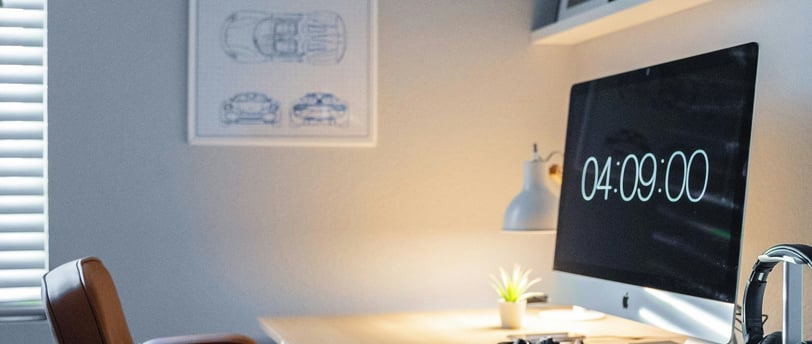8 Ways to Design Your Functional Home Office Space
Learn how to design a functional home office space with smart layouts, ergonomic furniture, and effective organization. Create a productive and stylish workspace tailored to your needs.
INTERIOR DESIGNORGANISING
1/30/20253 min read


With more people working remotely, having a well-designed home office is essential for productivity and comfort. Whether you have an entire room or a small corner, a functional workspace can boost efficiency and keep you focused. This guide will help you design a home office that is both practical and stylish.
1. Choose the Right Location
Selecting the perfect spot for your home office depends on the available space and your work habits.
Dedicated Room: If you have an extra room, converting it into a home office provides privacy and fewer distractions.
Multi-Functional Spaces: If a separate room isn’t an option, a quiet corner in the living room, bedroom, or even under a staircase can work.
Natural Light: Position your desk near a window to maximize daylight exposure and improve focus.
Minimize Noise: Choose a location away from high-traffic areas to reduce interruptions and background noise.
2. Invest in Ergonomic Furniture
Comfort is key when setting up a functional home office. Investing in ergonomic furniture prevents strain and enhances productivity.
Adjustable Desk: A sit-stand desk allows you to switch between sitting and standing throughout the day.
Ergonomic Chair: A chair with lumbar support, adjustable armrests, and proper cushioning helps maintain good posture.
Monitor Placement: Position your screen at eye level to reduce neck and back strain.
Keyboard and Mouse: Use an ergonomic keyboard and mouse to prevent wrist discomfort.
3.Optimize_Your Workspace Layout
Arranging your office efficiently can improve workflow and keep your space organized.
L-Shaped Layout: Ideal for multitasking, providing ample space for different work activities.
Minimalist Setup: Keep only essential items on your desk to maintain a clutter-free environment.
Storage Solutions: Utilize shelves, filing cabinets, and wall-mounted organizers to keep supplies within reach.
Cable Management: Use cable clips or under-desk trays to keep cords tidy and avoid distractions.
4. Enhance Lighting for Productivity
Proper lighting reduces eye strain and enhances concentration.
Natural Light: Maximize sunlight exposure to create an inviting atmosphere.
Task Lighting: Use a desk lamp with adjustable brightness for focused work.
Ambient Lighting: Soft overhead lighting can create a comfortable workspace.
Blue Light Filters: Reduce screen glare and protect your eyes with blue light filtering options.
5. Personalize Your Home Office
A personalized workspace can boost creativity and motivation.
Incorporate Plants: Greenery improves air quality and adds a refreshing touch to your workspace.
Decor and Artwork: Choose motivational prints, calming colors, or stylish decor that reflects your personality.
Comfort Elements: Add a cozy rug, cushions, or a warm throw blanket to make your office inviting.
Soundproofing: If needed, use area rugs, curtains, or acoustic panels to reduce noise distractions.
6. Ensure Strong Connectivity and Tech Setup
A well-equipped office ensures seamless workflow and communication.
High-Speed Internet: Invest in a reliable Wi-Fi connection to avoid interruptions.
Dual Monitors: Multiple screens can improve productivity for multitasking professionals.
Noise-Canceling Headphones: Ideal for video calls and focus-intensive tasks.
Backup Power Supply: A UPS (uninterruptible power supply) protects against power outages.
7. Organize and Declutter Regularly
A clean workspace enhances efficiency and minimizes distractions.
Declutter Daily: Remove unnecessary items from your desk each day.
Storage Bins: Keep important documents organized and accessible.
Labeling System: Use labels to categorize files and supplies for easy retrieval.
Digital Organization: Utilize cloud storage for important files and reduce paper clutter.
8. Maintain Work-Life Balance
Creating boundaries between work and personal life is essential when working from home.
Set a Schedule: Establish clear working hours to maintain productivity and avoid burnout.
Designate Break Areas: Step away from your desk for breaks to refresh your mind.
Keep Work Separate: If possible, close your office door at the end of the day to signal the transition between work and home life.
Conclusion
Designing a functional home office space involves strategic planning and thoughtful choices. By selecting the right location, investing in ergonomic furniture, optimizing your layout, and incorporating personal touches, you can create a productive and inspiring workspace. With the right balance of comfort, organization, and technology, your home office can help you stay efficient and motivated every day.


Follow Us
Explore smart furniture ideas for modern living.
For Enquiry
contact: info@urbanspacee.com,
+91 91886 37751
© 2025. All rights reserved./Terms and Conditions/Privacy policy
Newsletters
This blog contains affiliate links.For promoting there products ,we may earn a commission if you purchase through these links, at no extra cost to you.
